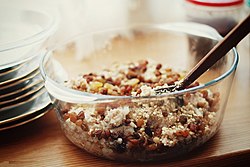Kutia
 Kutia in a ceramic makitra | |
| Main ingredients | Wheatberries, poppy seeds, honey or sugar, various nuts and sometimes raisins; milk or cream |
|---|---|
Kutia is a sweet grain pudding, traditionally served in Ukraine, Belarus, Russian and some parts of Poland. Sochivo, a dish similar to kutia, is very popular in Russia. Kutia is often the first dish in the traditional twelve-dish Christmas Eve supper (also known as Svyatah Vecherya). It is rarely served at other times of the year.
Description
It resembles koliva from Serbia or Romania (used usually for funerals), but the latter is mixed only with walnuts, sugar and raisins.
Kutia was also part of a common Eastern Orthodox tradition in the Russian Empire, which had waned in popularity as a result of the official atheism of the former Soviet Union, but has had a subsequent resurgence in Ukraine, Belarus and other former Soviet Republics. Radonitsa is one such holiday during which it is served. To this day kutia is served at funerals across Russia as a dish of remembrance.
Traditionally it was made of wheatberries, poppy seeds, honey (or sugar), various nuts and sometimes raisins. In many recipes milk or cream is also used. In some Slavic countries, rice is the main ingredient.
Nowadays, other ingredients (which were unavailable or just too expensive in earlier centuries) like almonds and pieces of oranges are added. In some places (like Poland, Ukraine, and western Canada), unprocessed wheat grain for kutia is easily available in stores. In others, where it is harder to find, it can be replaced by other similar grains like barley.
